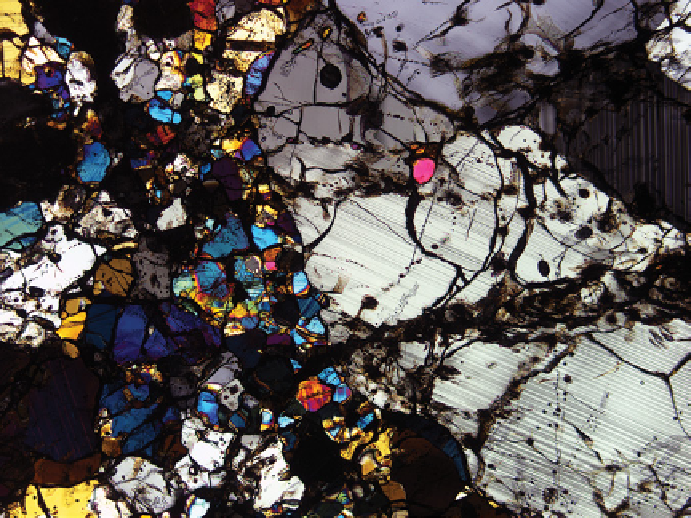Geology Reference
In-Depth Information
Figure 5.7.
gRA 06128 (shown here) and paired gRA 06129 are unique feldspar-rich brachinites that represent a melt (possibly
with some crystal accumulation), rather than cumulates or restites. The image is 2.5 mm across.
0.1-0.3 mm in Brachina up to 2-3 mm in AlH 84025
and gRA 06128/9. High-Ca pyroxene, chromite, and
plagioclase are typically interstitial to olivine. Sulfide is
anhedral and interstitial, or occurs as veins cross-cutting
other phases.
Olivine is homogeneous in composition within each
brachinite and ranges from mg# 64 to 72 among the oliv-
ine-dominated members. gRA 06128/9 contain olivine
grains with mg# of ~40, much more ferroan than in the
olivine-rich brachinites. High-Ca pyroxene varies from
augite to diopside (42-47 mole% Wo), but augite in
Brachina has a lower Ca content, ~39 mole% Wo. The
calcic pyroxenes are magnesian with mg# = 79-84 except
for gRA 06128/9 whose augites have an mg# of ~65.
There are orthopyroxene analyses for only a few brachi-
nites in the literature; they are magnesian (mg# 72-75)
with the exception of gRA 06128/9 with mg# of ~54.
Compositional data are available for roughly half the
brachinites, and there are substantial differences in their
compositions [
Day et al.
, 2009, 2012a;
Goodrich et al.
,
2010;
Johnson et al.
, 1977;
Mittlefehldt et al.
, 2003;
Nehru
et al.
, 1983;
Shearer et al.
, 2010, 2011;
Swindle et al.
, 1998;
Warren and Kallemeyn
, 1989]. Brachina is quite unusual
compared to the other ultramafic brachinites in that it
has approximately chondritic (CI) abundances for most
refractory and moderately volatile lithophile elements. Its
lithophile element pattern betrays no hint of fractionations
imposed by igneous processes. All other ultramafic brachi-
nites show depletions in highly incompatible lithophile
elements relative to less incompatible elements, for
example, e.g., la/Yb, Th/Yb <1 × CI. However, lithophile
trace element abundances are tricky to interpret in many
brachinites because most are finds from “hot deserts”
where alteration and contamination by the terrestrial
environment can have seriously degraded the samples
[
Crozaz et al.
, 2003]. This is not an issue with the Antarctic
brachinites. AlH 84025 (Plate 48) has low CI-normalized
abundances for Al and Na, consistent with the absence of
plagioclase, and is poor in highly incompatible refractory
lithophile elements such as la and Sm. Oddly, Eu/Sm is
>2 × CI in AlH 84025, suggesting that some plagioclase
is present, although it has not been observed. EET
99402/7 have very fractionated lithophile element
patterns, with higher abundances of the “plagiophile”
elements Na, Al, and Eu and very low abundances of Zr,
la, Sm, and Yb, as well as Zr/Yb, la/Yb, and Sm/Yb
<1 × CI. With the exceptions of AlH 84025 and EET
99402/7, ultramafic brachinites have approximately chon-
dritic Eu/Sm ratios. The mafic brachinites gRA 06128/9
are rich in most incompatible lithophile elements with
abundances between ~3 and 8 × CI. Exceptions are the
high field strength elements Ti, Zr, Nb, Hf, and Ta which
are at ~1-2 × CI.
Most brachinites have low abundances of the highly
siderophile elements with Ru, Pd, Re, Os, Ir, and Pt
typically <0.5 × CI, but exceptions are NWA 6077
(0.8-1.1 × CI excluding Pd at ~0.4 × CI) and NWA 5400
(1.7-5.0 × CI excluding Pd at ~0.3 × CI) [
Day et al.
, 2012a].

